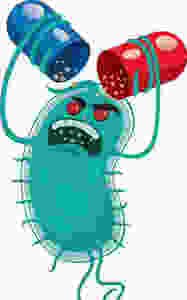Bacteria were one of the first life forms to appear on earth. Though only unicellular, their biomass is greater than that of animals and plants combined. This is because they are found virtually everywhere. Around you, on you and even inside you! Most of these bacteria are harmless and some are beneficial, helping your digestion and immunity. However, a handful are actually harmful and cause disease. Fortunately, We have amazing medicines to fight these dangerous bacteria off. They’re called antibiotics.
Synthesized from mould, chemicals and other natural products these antibiotics kill or neutralize bacteria, making them harmless. Antibiotics interfere with essential processes of the bacteria like protein synthesis and disrupt cell wall growth all while leaving the human unharmed. They are used for everything from surgery to chemotherapy and organ transplants to fighting off a minor infection. Routine medical procedures would be life-threatening without them. Unfortunately, some bacteria can become resistant to antibiotics and thereby are no longer affected by their presence. So how does antibiotic resistance develop and what can we do to stop it?
Just like any other organism, individual bacteria can undergo random mutations. Most of these will be useless and cause no damage. However, one odd mutation could make a bacteria resistant to an antibiotic. All other strains of bacteria without a mutation that makes them antibiotic-resistant will die out, Leaving only the harmful, disease-causing bacteria, as per Darwin’s theory of natural selection. After the non-resistant bacteria have been wiped out the resistant ones have more resources and better conditions to survive. These mutant genes are passed down not only through reproduction. Some bacteria can release their DNA post-death to be picked up by other bacteria who can also be of a different species! While some can also pass the genetic material through bacterial conjugation. Over time, the resistant genes proliferate, creating entire strains of resistant bacteria now called superbugs. Some strains of staphylococcus aureus that cause diseases ranging from sepsis and skin infections to pneumonia have now become superbugs resistant to beta-lactam antibiotics, like penicillin, the first discovered antibiotic. These superbugs through their mutant gene can maintain an unhindered cell wall preventing the anti-biotic from doing any damage. The salmonella superbug can produce enzymes that can break down antibiotic attackers before they can do any damage.
Getting rid of superbugs is a daunting task. Bacterial resistance began to appear in the 1940s and 50s. But pharmaceutical companies countered the problem of resistance by discovering many new antibiotics. This made them a highly profitable enterprise. However, antibiotics were overprescribed. They were also given to patients with viral infections, even though they would be completely useless. As prescription regulation of these drugs began, it helped reduce the formation of superbugs due to lack of exposure to the drug. But this also reduces the profitability of antibiotics. Even newly discovered antibiotics are not as broadly applicable as the initial ones were, making them even less profitable. Hence companies have stopped trying to discover new antibiotics. So superbugs have become resistant to multiple antibiotics. So how do we fight this problem?
Action needs to be taken to get rid of superbugs. We need to strictly control the use of existing antibiotics and create new ones to fight these mutants and prevent more from forming. Agriculture is the largest consumer of antibiotics. Using hefty amounts of them in animals can lead to the development of superbugs. Many of these can infect humans and can spread like the coronavirus is spreading. Organisms like fungi have evolved over the years and contain antibiotic compounds to give them a survival advantage over certain bacteria. These can be converted to antibiotics for humans. We can also package antibiotics with molecules that inhibit resistance. Bacteria develop resistance by degrading a drug with their protein. By packaging an antibiotic with molecules that block degraders also prevents the formation of superbugs. Another way is to use viruses, (Phages) that attack bacteria but not humans. Antibiotics also need to become profitable again. The UK is testing a model, in which healthcare providers purchase antibiotic subscriptions, thereby shifting the profits away from the actual amount of antibiotics sold. However, these programs are still in their initial stages and we are a long way from adopting such systems globally. Much more needs to be done, but with sufficient control of antibiotics and increased investing in antibiotic production, we can get ahead of the superbugs.
CHECK OUT MORE SUCH ARTICLES AT
https://curativecommunity.wixsite.com/curativecommunity
Bibliography
Wright, Gerry. “How Can We Solve the Antibiotic Resistance Crisis?” YouTube, 16 Mar. 2020, www.youtube.com/watch?v=ZvhFeGEDFC8&t=15s. Accessed 9 June 2020.
Wu, Kevin. “What Causes Antibiotic Resistance?” YouTube, 7 Aug. 2014, www.youtube.com/watch?v=znnp-Ivj2ek&t=11s. Accessed 9 June 2020.
Tosh, Pritish K. “Protect Yourself from Superbugs.” Mayo Clinic, 2018, www.mayoclinic.org/diseases-conditions/infectious-diseases/expert-answers/superbugs/faq-20129283.
World. “Antibiotic Resistance.” Who.Int, World Health Organization: WHO, 5 Feb. 2018, www.who.int/news-room/fact-sheets/detail/antibiotic-resistance.










Comments
Post a Comment